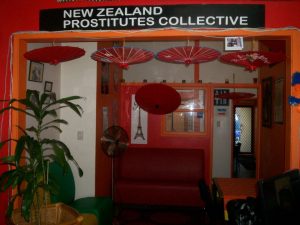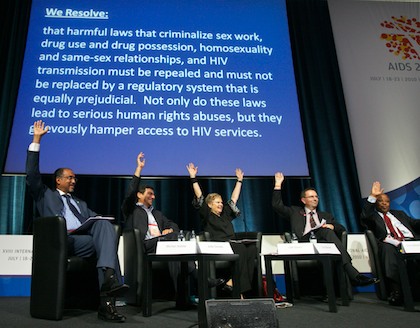
Arielle Heighton
“I’d always thought a union was needed. After eight years in the sex industry, forming the collective, although no a union, seemed like a positive step forward towards empowerment for sex workers – Sarah, founding member [of New Zealand Prostitutes Collective] ” (Jordan, 271).
The New Zealand Prostitutes’ Collective (NZPC) has played a leading and crucial role in the fight to decriminalize sex work in New Zealand. The country is both praised and ridiculed for its legal approach of decriminalization, but how have the jobs and lives of sex workers actually improved or worsened since the Reform Act was passed in 2003? Through this project I will show what the NZPC has been doing since then to improve the livelihood of sex workers within their country and how it is standing in solidarity with other sex workers around the globe by “fighting the legal status quo, social mores and also mainstream feminism” (Bazelon).
A Brief History
The NZPC emerged before sex work was decriminalized in New Zealand, known in Maori as Aotearoa. Right before the NZPC formed, it was illegal to solicit sex for money in public spaces and most female sex workers were working as “masseuses” in massage parlors (Brunton, 1.) In 1978, the Massage Parlours Act (MPA) was introduced, requiring operators to have licenses, prohibiting them from hiring persons with drug-or prostitution-related convictions, and having files of all employees available at any moment for the police if requested. Police would be known to go undercover as clients in these parlors, encouraging the women to solicit sex for money to try and arrest them.
Early Stages of Organizing

Catherine Healy, a founding member of the New Zealand Prostitutes’ Collective, described that the initiative to start a collective came from “a feeling at the time that there was nothing there for [sex workers], they had no means of addressing their issues” (O’Leary). One night in 1987, years after the Massage Parlours Act was introduced, nine women, “masseuses” and street workers alike, met together in the national capital of Wellington to talk about the idea of forming an organization that represented New Zealand sex workers. Later, they connected with other sex workers, including cis men and women and transgender folks, to discuss concerns such as negative perceptions of sex workers, abusive or toxic bosses or managers, lack of legal rights, and HIV/AIDS prevention. One of the founding member remembers, “We met on beaches, sat round pub tables, huddled in doorways, and spoke on the telephone to unseen, like minded, sex workers throughout the country. Sex workers were on the move” (NZPC). These workers were sick of facing abuse, tired of living in fear, and having no autonomy in their workplace.
What’s In A Name?

When deciding on a name for the organization that was in the works, the group decided to use the term ‘prostitute’ rather than ‘sex worker’ for two reasons. The first reason was because they wanted to “confront the stigma attached” to the term ‘prostitute’ (Brunton 47). The other reason being that they wanted to stand in solidarity with other collectives around the world that also used the term ‘prostitute’ in their titles. Some of these included Australia’s Prostitutes’ Collective of Victoria (PCV) and England’s English Collective of Prostitutes.
Receiving Funding

In 1988, the Ministry of Health contacted the Collective to discuss providing funding in order to create a drop-in center providing services to sex workers including HIV/AIDS prevention, education, a free health clinic, networking, and general support. This was a major victory for the Collective but they had worries about “losing its autonomy to express its thoughts” (Brunton, 47) after the government funding was received. Ultimately the NZPC saw it as a chance to make real change that was led by sex workers themselves. In response to their own fears, they were cautious to remain relevant and sex worker-driven in the midst of receiving government funding. The collective received NZ$50,000 per year from the department to form community drop-in support centers, produce a magazine that provided a voice to different invisible sectors of the sex industry, strengthen sex workers’ social networks and peer support, and operate a condom distribution program throughout the country. All of these objectives incorporated education on safe-sex strategies to the public and sex workers themselves. Still, even with the endorsement of the right to exist by the funding of the Ministry of Health, the collective “still had to deal with practical problems like persuading landlords, office suppliers and telephone company that [they] were a legitimate organisation. It was a time of coming out” (Jordan, 272).
Police Raids
The NZPC, after receiving funding, informed Wellington vice police that they were organizing a group of sex workers that intended to “come out,” so to speak, about what they did for a living in order to be involved with HIV prevention. Although local vice officers at the time were “immediately supportive” (Brunton 48), the squads that followed were not.
Just a few years later in 1991, police raids started to become more and more frequent on the streets and in massage parlors where they would pose as clients. The police would use safe-sex literature and condoms that were provided by the NZPC as evidence to arrest sex workers. The result of the raids left sex workers “increasingly reluctant to identify themselves as such” (Brunton 52), which made it extremely difficult for the collective to build networks and outreach within the sex-worker community.
The NZPC wrote a letter to “the Ministry of Health that [they] would be unable to continue providing services funded by them, unless an interdepartmental committee was established to examine the conflict between government agencies” (About). The request was fulfilled and a committee was established; it included the police, the Department of Health, the Ministry of Justice, and the Ministry of Women’s Affairs. A policy directive was created that required local police to stop seizing condoms and literature from the NZPC and use them as evidence when prosecuting sex workers.
Building Reform

The journey to decriminalization and reform was beginning. Over time the NZPC gained the support for law reform from the Business and Professional Women’s Federation, the Young Women’s Christian Association (YWCA), the National Council of Women (Brunton, 53), the National Council of Women of New Zealand (NCWNZ), National Collective of Independent Women’s Refuges, the Family Planning Association, the AIDS Foundations, and the public health sector (Crichton). Libertarians also found reform appealing because “it was taking the weight of the state off of people’s shoulders” (Crichton). Tim Barnett, a future General-Secretary of the Labour Party and a former Member of Parliament, was requested by Catherine Healy to become involved with a pro-decriminalization bill that eventually passed in 2003 and became the Prostitution Reform Act (PRA) (Brunton, 62).
Reviewing the Reform Act
Although many in opposition to the PRA “feared its introduction would lead to an explosion of brothels and of human trafficking” (Crichton 2015), an independent review by the Christchurch School of Medicine (CSoM) found that through “quantitative and qualitative methods…90 percent of sex workers believed the PRA gave them employment, legal and health and safety rights. A substantial 64 percent found it easier to refuse clients. [And] Significantly, 57 percent said police attitudes to sex workers changed for the better” (Crichton). The CSoM also confirmed that the PRA did not change the number of people working in the sex industry, but that more sex workers were using safe-sex practices.

Legalization vs. Decriminalization
Long before the PRA, many sex workers had hopes of decriminalization in their future. Sarah, a sex worker and masseuse in the 1980s, describes her wish for decriminalization in June Jordan’s Working Girl:
“I do think the laws on prostitution need to be changed. I’d like to see it decriminalised, not legalised. If it was legalised, we’d end up with the same sort of situation as they’ve got in Melbourne. The guys pay for everything at the desk, and then the girls have to do them whether they want to or not. And the prices would go right down because competition would be rife — legalised pimping” (Jordan, 29).
What Sarah is describing in Melbourne, Australia, is the legalization of sex work as opposed to the decriminalization of it. These are two very different approaches to reform, although the media tends to treat them as if they are one in the same when writing about sex work.
What’s the Difference?
In 2014, Forbes magazine noted, “there are also places like New Zealand and Germany where the entire system is legal and out in the open” (Worstall). The language used in lumping New Zealand and Germany’s sex work laws is dangerous. In Germany, sex work is legalized, not decriminalized. Legalization, as opposed to decriminalization, is “not a great model for human rights. And in state-controlled prostitution, commercial sex can only happen in certain legally-designated areas or venues, and sex workers are made to comply with special restrictions, like registration and forced health checks” (Mac). Legalization is often referred to as “backdoor criminalization” because more vulnerable people will not be able to comply with regulations, forcing them to work illegally, leaving only the wealthier brothel owners able to benefit from legalization, as is the case in Germany (Bazelon). Considering that sex work has always been a survival strategy for all kinds of “unpopular minority groups” (Mac), including low-income women, women of color, houseless and trans folks, it is clear that legalization is not in the best interests of sex workers.
Decriminalization means that all the laws that enforce penalty on any consensual, private adult exchange of sex for money would be repealed. It would simply no longer be a criminal act and could create safe ways for sex workers to “openly discuss their work, describe its pros and cons, demand that abuses cease, seek employment benefits, obtain police protection, and improve working conditions” (Ertman 261). Decriminalization makes conditions safer for people who choose to enter the field of sex work and treats the worker like you would in any other field of work.
Abuse and Violence

Many sex workers will not go to the police after rape or other forms of abuse because of fear of arrest or past traumatic experiences, including cases of being raped by police themselves (Jordan, 266). In the case of Meg Muñoz, a former sex worker and activist, there was a time in her life where she was blackmailed by an ex-boyfriend, threatening to tell the police and even her family what she did for a living if she did not comply with what he wanted (Bazelon). In the 1980s a former sex worker named Bridget reflected on how horrible bosses would treat her and her coworkers since “most know they can get away with it” because it was too risky for them to go to the police (Jordan, 142). Abuse by a boss, partner, or cop is an all-too-common reality for sex workers, even in countries using the legalization approach. Legalization “creates a two-tiered system: legal and illegal work” which means those who are still working illegally will be more vulnerable to abusers (Mac).
Accountability
Because of the NZPC’s fight for decriminalization, abusers are more likely to be held accountable in New Zealand. Fast forward 11 years after the PRA was passed through Parliament, a New Zealand sex worker was awarded $25,000 in a sexual harassment case against her boss (Duff). By decriminalizing sex work, New Zealand is “improving employment conditions, including protection from harassment by the sex worker’s employer” (Schwartz).
Pitfalls of Decriminalization
In New Zealand, there are gaps in the Reform Act. For example, it is only decriminalized sex work for New Zealanders themselves. Like mentioned earlier, sex work has been a survival strategy for marginalized groups, including immigrants. In The New Zealand Herald, immigration adviser Tuariki Delamere tells us that because the law only applies to New Zealanders it “drives foreign prostitutes underground and makes it hard to ensure occupational health and safety laws are kept” (Tan). These sex workers are not getting the local support that they need because of their immigration status. New Zealand is headed in the right direction, but still has work to do.
More Air Time for the Swedish Model
Many wonder why New Zealand did not implement the Swedish (or Nordic) Model (which makes it a crime to buy sex but not to sell it) considering it is “often described as a feminist victory for criminalising men who buy sex” (Grant). The mainstream media as well as mainstream feminists tend to glorify the Swedish Model because prostitution is often seen as male violence against women. Yasmeen Hassan is the global executive director of Equality Now, a women’s rights group campaigning against human trafficking. She believes “if prostitution is legal, and men can buy women’s bodies with impunity, it’s the extreme sexualization of women” (Bazelon). Once again we see the language of the terms ‘legalization’ and ‘decriminalization’ lumped together as one kind of reform policy. CNN reported that the United States, “Congress should enact legislation along the lines of the Nordic Model without delay. Prostitution is a human rights issue, and it is long overdue for reform” (Peters).

However, former New Zealand MP Tim Barnett sees the “continued campaign for the Swedish model as misguided” because this traditional Western feminist view reinforces this idea that all sex workers are victims which strips women of their agency and autonomy (Crichton). Swedish sex worker and president of the Global Network of Sex Work Projects Pye Jakobsson insists that this model enhances stigma and ultimately hurts sex workers. She explains that “people think the Swedish state criminalized clients, and not us” (Bazelon) but really it pushes sex workers to take greater risks than before and puts them into dangerous situations by attracting more experienced abusers.
After ten years of implementing the model, the Swedish government announced to the public that street prostitution was down by 50%, even though “no one had recorded data on street prostitution before the law passed,” and the law was passed off as a success (Bazelon). Even still, when opponents of the model came forward with the negative effects it had on sex workers, the Swedish government responded by saying they “must be viewed as positive from the perspective that the purpose of the law is indeed to combat prostitution” which they see as inherently immoral or demeaning (Bazelon). The Swedish government failed to have “any meaningful consultation with women who sell sex” (Grant). Unfortunately, this is a common theme when both determining legislation and writing media articles around sex work.
Conclusion

When it comes to supporting sex workers, the NZPC, as well as other collectives around the world, have made centering sex worker’s voices essential. Some sex worker-run collectives, like the one in Sonagachi, a red light district in Kolkata, India, even run schools for the kids of sex workers, and have banks set up that will not discriminate when it comes to loans (Bazelon).
However, when it comes to writing about sex work, sex-worker voices are rarely heard in mainstream media sources. More often than not I had to look at independent media outlets to even get a quote directly from a sex worker, and only one article I read mentioned trans women or women of color. In addition, no articles ever referenced Maori sex workers, even though they made up one half of all soliciting convictions and “were among the worst affected by policing, prosecution, violence, and stigma” (NZPC). While sex workers continue to fight for a place at the debate podium, anti-prostitution activists continue to silence their voices saying things like “it would be ‘inappropriate to discuss sexual slavery with prostitute women” (Grant). Even if sex workers are allowed a spot at the debate podium, they are often offered less pay than non-sex worker speakers weighing in on the same topic (Grant).
It is important in the fight for reform that the experiences and lives of all sex workers are not lumped together, nor should we expect sex workers “to defend the existence of sex work in order to have the right to do it free from harm” (Grant). While white women tend to be the ones who “publicly argue the case for decriminalization” (Bazelon), people of color and trans women find it harder to get an audience. Trans women are also more likely to experience job discrimination, making it harder to leave the industry even if they wanted too (Bazelon).

Each sex worker has their own experience, as does everyone in any line of work. That experience cannot be understood by forcing sex workers to choose between finding their job as empowering or exploitative. Furthermore, their grievances about their work cannot be continued to be used as evidence for abolitionists’ assumption that every sex worker wishes to exit the industry.
Collectives such as the NZPC continues today to be run by and for sex workers to “represent their interests socially, legally, and politically” (Jordan, 270). When it comes to reform on laws, what New Zealand got right was that sex workers themselves, specifically the NZPC, were taking the lead on advancing legislation “and has since been evaluated with their participation” (Grant). Even though most mainstream feminists have tended to focus on “saving” sex workers, in the case of New Zealand, sex workers were the ones who got to decide what was best for them. Through the work of the NZPC, decriminalization is placing “greater control into the hands of sex workers to operate independently, self-organize in informal cooperatives and control their own working environments” (Bazelon).
Sources
Bazelon, E. (2016, May 5). Should prostitution be a crime? The New York Times.
Brown, E.N. (2014, July 18). What the Swedish model gets wrong about prostitution. Time.
Brunton, C., Fitzgerald, L., Healy, C., Abel, G. (2010). Taking the crime out of sex work: New Zealand sex workers’ fight for decriminalisation. Bristol, UK: Policy Press.
Crichton, F. (2015, August 21). Decriminalising sex work in New Zealand: its history and impact. OpenDemocracy.
Ditmore, M. H., Levy, A., & Willman, A. (2010). Sex work matters: Exploring money, power, and intimacy in the sex industry. London: Zed Books.
Duff, M. (2014, January 3). Sex worker gets $25,000 over harassment. Stuff.
Ertman, M. M., & Williams, J. C. (2005). Rethinking commodification: Cases and readings in law and culture. New York: New York University Press.
Grant, M. (2014, March 15). Will nobody listen to the sex workers? The Guardian.
Jordan, J. (1991). Working girls: women in the New Zealand sex industry talk to Jan Jordan. Auckland, N.Z.: Penguin.
Mac, J. (2016, January). Juno Mac: The laws that sex workers really want. TED.
New Zealand Prostitutes’ Collective. (n.d.). About NZPC. New Zealand Prostitutes’ Collective.
New Zealand Prostitutes Collective. (2013). Decriminalization of sex work in New Zealand: Impact of Maori. NZPC.
Peters, M. (2016, April 18). Nordic Model key to beating exploitation of sex workers. CNN.
O’Leary, C. (Director), & Burke, V. (Producer). (1994). A Double Standard [Video file]. NZ On Screen.
Olds, J. (2016, February 28). The rules of the game: did New Zealand get its prostitution laws right? Stuff.
Schwartz, D. (2014, June 5). Sex workers like New Zealand law, not Canada’s new ‘Nordic model’ for prostitution. CBC News.
Tan, L. (2015, Dec 4). Increase in foreign sex workers in New Zealand. New Zealand Herald.
Worstall, T. (2014, August 11). One benefit of legalised prostitution seen in New Zealand. Forbes.